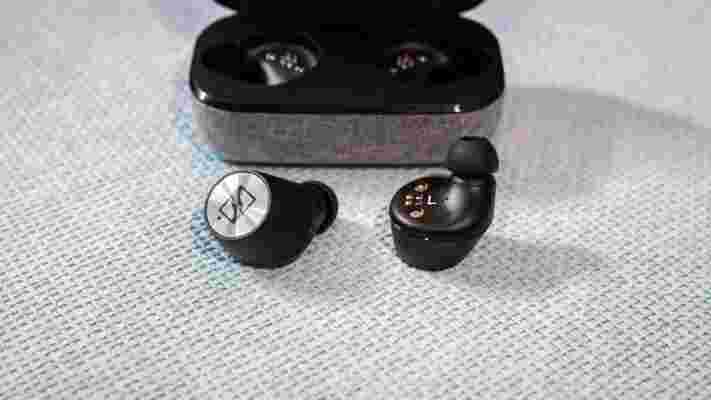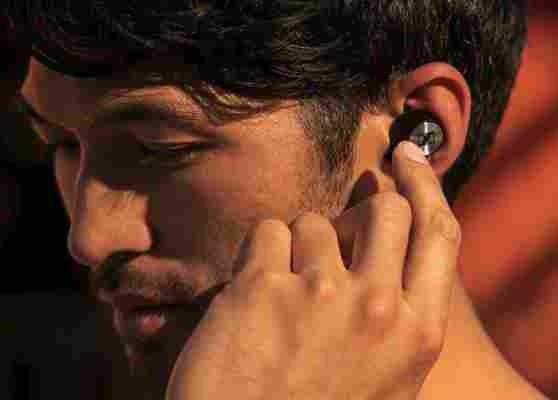Review: Sennheiser’s Momentum True Wireless are the AirPods upgrade I’ve been waiting for
As a general rule, I don’t like ‘true wireless’ headphones.

Don’t get me wrong; I like the concept, but ever since Apple’s AirPods popularized the category, I’ve been hesitant to adopt the newfangled form factor because of all the compromises entailed. Until now, none of the headphones I’ve tried have cleared my threshold for five key areas:
Then Sennheiser’s Momentum True Wireless (MTW) came along. At $300 , they’re more expensive than most of the competition, but these are the first true wireless headphones I can wholeheartedly recommend to both audio-enthusiasts and mainstream users alike.
By far my biggest problem with true wireless headphones is lackluster sound, at least for the price. I waited for the Momentums with eager anticipation, given Sennheiser’s venerable audio pedigree, and I’m glad to report the company delivered. Though I haven’t tried all the competition, I have used more than most, and the Momentums are only the second pair of true wireless headphones that don’t immediately make me want to reach for traditional Bluetooth buds or wired ones. The first pair was Master and Dynamic’s MW07, but I prefer the Sennheiser’s tuning, and it wins out on connectivity, fit, and features too.
The MTW is designed smartly. The housings appear quite bulky at first glance, but in my medium-sized ears, they fit like a glove. The body gently tapers into a small sound tube, leaving the largest part to rest outside your ear canal; I’ve had worse fit issues with far smaller earbuds. I had no issue wearing the MTW for hours, and given my ears can be finnicky about fit, I suspect most people won’t either.


This cozy fit contributes to the fantastic isolation from the outside world – some of the best in the category. Unlike AirPods, which let you hear all your surroundings, the Momentum True Wireless block out more noise than most full-size noise-cancelling headphones.
Though I don’t have the equipment to measure the noise isolation – I’d venture to say they’re right up there with Sony’s 1000XM3 in their ability to shut up the world, especially if you replace the included silicone tips with foam tips. And for those times you want to be aware of your surroundings, a double tap on the right earbud enables a ‘Transparent Hearing’ mode that uses the onboard microphones to let you hear your environment.
The controls are well thought out and work with minimal delay. Large touch surfaces let you control playback on the left ear, and smart features on the right. I particularly appreciate how Google Assistant and Siri only require a single tap on the right earbud – it makes voice assistants more useful than the usual “hold for two seconds” approach on other headphones.
Likewise, you can initiate Bluetooth pairing by simply touching both earbuds for 5 seconds, which is a lot easier than the usual power off-and-on-then-hold cycle on the competition. It would’ve been nice to be connected to multiple devices at once, but this works fast enough.
The oddity is volume control, which you do by holding down on the left or right earbuds. It’s weird at first, but you get used to it quickly – and it’s certainly better than asking Siri to raise the volume as one would on AirPods. I wish you could customize the buttons via Sennheiser’s Smart Control app though.
The charging case is the usual fare. It’s small, and getting the earbuds in and out is quick enough. I wish it held more than just two additional charges (a total of twelve hours), but I’m happy it uses USB-C. Far too many charging cases use micro-USB, which as far as I’m concerned, is reason enough not to buy one. I don’t need to carry around an extra cable for something that’s supposed to cut down on the wires.
Battery life on the earbuds themselves is good enough for my uses. They last four hours on a charge, and though I haven’t managed to drain them completely, I did listen for over three hours at max volume at one point before plopping them into their charging case. They charge quickly too, topped back up within the hour. And since the case uses USB-C, it’s easy to use your phone charger – or even some laptop charges.
Unfortunately, some users are experiencing some problems with the charging case. In some cases, it seems the earbuds don’t shut off properly when the case is closed, allowing the battery to drain. In any case, standby time isn’t great; Sennheiser claims they’ll last seven days in standby mode, but in practice, it seems to be less. You won’t notice if you use the headphones often, but it’s annoying if you haven’t used them for a few days and find the buds are totally drained.
Those concerns acknowledged, lets return to the sound: The MTW is exquisite. Not just ‘good enough for a commute’ but just flat-out good. Of course, it won’t beat a $300 pair of wired earbuds, but it’s up there among the Bluetooth competition. The overall tuning is a bit v-shaped, with an emphasis on the bass and treble, which is just how I like it. Bass reaches down low into the sub-bass, hits well in the midbass, and for the most part doesn’t muddy up the mids. It’s not the fastest bass around – there’s a bit more midbass than I’d like, but it’s good and punchy.
Treble is detailed and extends easily to the high end. It can be slightly abrasive on some poorly mastered tracks with a lot of sibilance, but for the most part, helps drive out cymbals and other bits of detail in the mix. The MTW present ample detail in busy tracks, and do a decent job separating instruments during busy passages.
Better yet, if the sound doesn’t suit you, there’s a simple equalizer in Sennheiser’s app that lets you add or remove bass and treble energy. The effect doesn’t allow for a ton of specific control, but is easy to use and can have a significant impact on the sound. I personally toned down the bass a bit for a slightly flatter response. Thankfully, the changes carry over to any other devices you pair them with.
My only wish is that they got a bit louder. It’s good enough for most music, but some tracks – classical music in particular – are recorded with a wide dynamic range, making quiet passages a little too quiet. This is a complaint I’ve levied at most true wireless buds I’ve tried though, and the Sennheisers block out more noise than most, so you don’t always have to turn up the volume all the way.
To my ears, Master and Dynamics MW07 actually resolve a bit more detail with their beryllium drivers, but I prefer the more energetic tuning of the Sennheisers to M&D’s warmth. Tuning is subjective and can be dealt with an equalizer, but it’s also worth noting that even if the MW07 have a slight technical advantage, the additional isolation on the Sennheisers makes it easier to appreciate the small details during a loud commute anyway.
In case you’re wondering what they sound like against Apple’s Airpods, there’s no competition. While I do think Apple’s AirPods get an unfairly bad rep in audio communities, they are not even in the same league as these.
Both AptX and AAC are on board so both Android and iOS users have access to a high-quality Bluetooth codec. AptX Low Latency also makes a rare appearance, meaning voices are always in sync when watching videos, and making the MTW one of the few true wireless earbuds suitable for tasks demanding minimal audio delay.
Moreover, the MTW has the most rock-solid Bluetooth connection I’ve heard from this form factor. Over several days with hours of listening indoor and out, sound never dropped out. I can’t even say that about some full-size Bluetooth headphones.
My list of complaints is small. I could always do with more battery life, and I would’ve gladly accepted a larger case to fit in an extra charge or two. I wish the earbuds got a bit louder for tracks with wide dynamic range. And I wouldn’t mind deeper integration with the Google Assistant, as seen on the Pixel Buds and Sony’s headphones.
But that’s about it. The Momentum True Wireless sound great, fit well, are easy to use, have a reliable connection, have decent battery life, block out oodles of noise, and still let you be aware of your surroundings if you want. It’s everything I could ask for in a pair of true wireless earbuds.
The headphones still haven’t been released – they’re due by the end of the month – but if you’re in the market for a pair of true wireless earbuds and have $300 to spend, look no further. Sennheiser hit the bullseye, and I expect these to become very popular, very fast.
Whether or not we like a product, we get a small cut of the revenue if you buy it through our affiliate link. This isn’t a sponsored post, but for the sake of transparency, you deserve to know what’s up.
Classic SNES controller returns with an upgrade: The Bluetooth SNES30 & smartphone holder
Our obsessions with latest and greatest in tech gadgets often leads us to forget the golden era of gaming, the Goldilocks zone where technology and imagination finally synced up to produce the childhood cornerstones for a generation of kids.

But 8Bitdo hasn’t forgotten, and they’re dedicated to reviving the perfection of one of the greatest gaming controllers ever made: the Super Nintendo classic grey controller.
They’ve brought it back with the SNES30 Controller , a 1:1 original design that supports both Bluetooth and USB connections, and added one exciting component: an expandable clipping phone mount. For a limited time, they’re available at just $34.95 on TNW Deals .
With Bluetooth and USB connections, you can enjoy this controller on your PC, Mac, consoles and beyond.
Every single detail about the controller, from the build itself, to the feel of the plastic, to the colors used, resembles that classic SNES controller from back in the day. The dimensions are identical to the millimeter, and the D-pad and buttons are fantastically responsive.
Slim, portable size and a dual-keyboard code system for iOS keeps your playing versatile, with Wiimote emulation support allowing up to four simultaneous players.
Save serious money while your gaming-nostalgia indulgence will have you feeling like a little kid again – take 22 percent off the SNES30 Bluetooth Game Controller & smartphone holder today on TNW Deals.
DJI launches a new emergency drone program in Europe
The European Emergency Number Association ( EENA ) and the Chinese drone manufacturer DJI just announced a new joint pilot project for using drones for emergency services in Europe. The project was announced at the EENA conference in Slovenia and will be the second partnership between EENA and DJI.

The goal of the project, which will take place in Ireland and Wales, is to understand exactly how drones can be used by emergency services and create legal and operational framework — and to set Europe-wide standards to help more countries adopt emergency drones. TNW is in Ljubljana, and we spoke with Alfonso Zamarro, EENA’s Drone Activities Manager, and Romeo Durscher, Director of Public Safety Integration at DJI, to find out more about the pilot project.
Making emergency service drones a reality
We’re bombarded with science fiction-like visions of what tech will be in the near future, but often it can feel like an eternity before what we see becomes ingrained in our daily lives. The truth is that futuristic visions and general implementations of tech won’t become a reality unless there are people willing to do the groundwork — and that’s exactly what DJI and EENA are doing.
The new project is a continuation of EENA’s and DJI’s joint venture in 2016 to 2017 where the first steps where taken to create drone usage guidelines for emergency services by working with early adopters and launching pilot programs around Europe. “Phase II will focus on the next level of integration, testing, and validation of data,” explains Durscher. “Based on phase I, and what we have learned and seen in the field, the drone itself is only a tool to provide better and faster data points. This important information needs to get into the right channels so decisions can be made either on scene or far removed at an incident command center.”
Video from phase I of the EENA/DJI partnership 2016-17.
These might not seem like particularly groundbreaking developments for the common layman but Durscher stresses the possibilities that projects like these might unlock down the road:
“The future may look even more differently — what if the firefighter on the ground could also tap into all the available data and see an incident from various different perspectives? What if algorithms helped providing suggestions during large scale events for next steps or give incident command data that would normally take hours to get? One thing is clear; both hardware and software solutions will continue to develop based on needs and the capabilities for first responders will increase.”
Durscher’s hopes for the future of emergency services are a grand and refreshingly non-dystopian look at increased drone usage. Even a cynical pessimist like me — that tries to disprove the benefit of drones — can’t argue against how cool it would be to use robots to save human lives. However, what’s truly important is the current ability of emergency drones and how they’ll be used in Europe during the project.
How exactly can a drone save your life?
Zamarro of the EENA says that one of the conclusions of the first phase of the EENA/DJI partnership was the clear benefits drones brought for fire fighters and search-and-rescue teams. Using EENA coordination efforts and emergency service experience — along with DJI’s technical knowledge – they were able to pinpoint where drones can help in these type of emergencies and what needed to be improved, e.g. durability of equipment, how to handle data and stream it to other responders, etc.
“Phase II will go one step further. We aim to understand how drones integrate tactically in those use cases and back it with data. For example: drones are good for search-and-rescue teams, but how can we use a drone in a rescue mission to find victims faster? That’s the level of detail we need to achieve now,” says Zamarro and adds that one of the aims of the second phase will be to compare data from drone teams and non-drone teams to get a concrete data on their effectiveness.


Durscher agrees that firefighting and search-and-rescue missions are currently where drones can do the most to save lives. In search-and-rescue missions they provide an excellent bird’s-eye view and in case of a fire, drones can be used to find hot spots which allow for a more targeted approach to putting it out. But Durscher adds that the possibilities for using drones to save lives only increase with every trial project.
The first EENA/DJI project resulted in technological advances in drones and it’s likely the second phase might also yield promising results. In the first project DJI used its Inspire 1 drones that were either outfitted with a visible light camera or its DJI/Flir XT thermal camera .
While the Inspire 1 was a huge step forward in drone technology back when it was unveiled in 2014 — and it’s still a workhorse today — DJI has released a series of the Matrice 200 series, which has even more enhanced capabilities. According to Durscher, the technological leap from the Inspire 1 to Matrice 200 was made possible by the many lessons learnt in the first EENA/DJI project.
It’s therefore safe to say that phase II will bring interesting results with its updated gadgets.
Credit: DJI Next steps
The teams in Ireland (Donegal Mountain Rescue Team) and Wales (Mid and West Wales Fire and Rescue Service) will soon start their drone programs. Both of the places were chosen by the DJI and EENA due to the experienced staff and favorable conditions to carry out as many drone-aided emergency services as possible — providing a great dataset for the future..
As to the general objectives/improvements of the new phase, EENA and DJI agree that there’s a lot of headway to be made when it comes to training new pilots and integrating drones in the workflow of emergency services. I mean, you can’t exactly hand a first responder a remote controlled drone and just tell her to go out and save lives. The main objectives can by summed up by three points:
Understand how to utilize drones during fire and search-and-rescue incidents, in addition to pre and post incident activities based on a statistical analysis
To deliver clear recommendations on how drones can be used by first responders in an operational level
To deliver recommendations to lawmakers and training entities on where first responders operate drones, how they do it and what type of training they need
For more information on the first phase of the EENA/DJI partnership, you can access a PDF version of the whitepaper here . And if you get lost in a forest, try waving at the drone above you — it’s trying to save your life.
